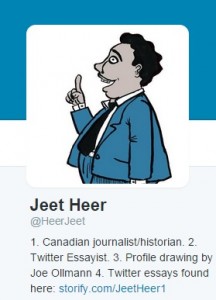
- I became interested in the “Twitter essay” as a genre during the Jian Ghomeshi scandal. #ghomeshi #surewastrendingforawhilethere #schadenfreude
- During that time, Oct and Nov 2014, Canadian journalist Jeet Heer @HeerJeet sent out a series of numbered tweets on the subject. #twitteressay #whoisthisguy
- They were captivating; some now collected on Storify.
- Turns out Heer has been numbering his Tweets long before Ghomeshi. #robford #aoscott #adulthood #plagarism
- Heer claims not to have invented the form, although he is credited with popularizing it.
- He says, “A Twitter essay isn’t really an argument; it’s the skeleton of an argument.”
- The essay is different from a Twitter storm (colourful example here) — which is merely a collection of tweets on the same subject. The essay has more form than this.
- The Twitter essay has strength!
- Followers can respond after the very first tweet, allowing the author to adjust direction and focus.
- Followers can retweet, generating interest and increasing the audience in real time.

- Immediate conversations and collaboration on Twitter affords what Heer calls “digital intimacy” not seen in other media.
- Unlike other forms of (solitary) writing, Twitter essays are performances.
- Author can directly address individuals in tweets, engaging their attention for dialog or response (@HeerJeet).
- When the tweets in an essay are numbered, you can tell when a single one is plucked from its context. #contextmatters #staytuned #moreonthis
- Heer announces the end of a series so followers aren’t kept on edges of seats. #theend
In using Twitter in this way, Heer has managed to subvert the expectation that a tweet must stand alone. When we get advice to “make it tweetable,” we are being asked to come up with an idea that can be communicated and understood by the intended audience in a 140 characters without any explanation or context. But Heer is, in the words of his colleague Michael Hingston, “bending the medium to his purposes,” and in so doing is arguably becoming one of Canada’s most interesting public intellectuals. Ta-Nehisi Coates of The Atlantic Monthly demanded “WHO ARE YOU????!!???” on first encountering Heer’s novel redefinition of the Twitter form, but there are now plenty of examples of others structuring their thoughts in this way.
There is more to say about Twitter and context. I explore this further in my next post.
For more on Jeet Heer, check out his (rather low-tech) website.